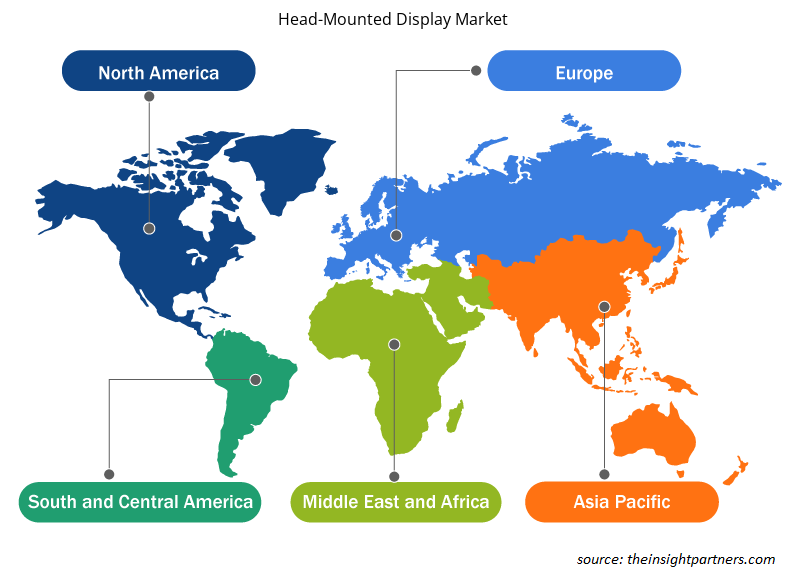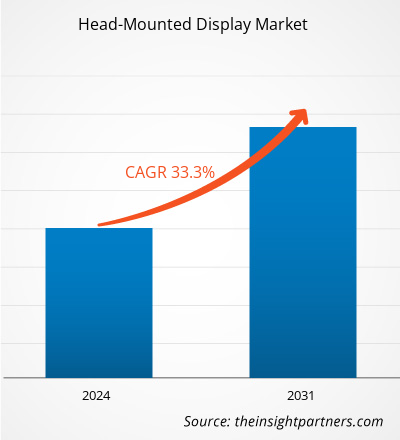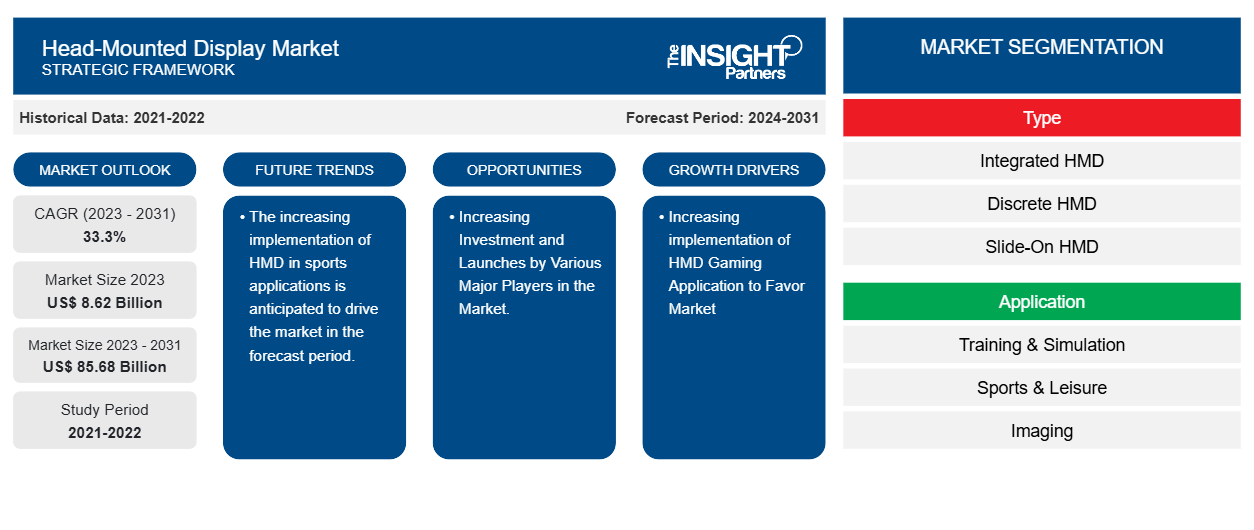Si prevede che la dimensione del mercato degli head-mounted display raggiungerà gli 85,68 miliardi di dollari entro il 2031, rispetto agli 8,62 miliardi di dollari del 2023. Si prevede che il mercato registrerà un CAGR del 33,3% nel periodo 2023-2031. L'implementazione di HMD nelle applicazioni di gioco e la crescente adozione di visori AR/VR nel settore militare saranno probabilmente i principali driver e trend del mercato.
Analisi di mercato dei display montati sulla testa
Il mercato degli head-mounted display sta vivendo una crescita significativa a livello globale. Questa crescita è attribuita a fattori quali l'implementazione di HMD nelle applicazioni di gioco e la crescente adozione di visori AR/VR nel settore militare. Inoltre, si prevede che il crescente investimento da parte dei principali attori nello sviluppo di HMD e nell'implementazione di HMD nelle applicazioni sportive offrirà diverse opportunità per il mercato nei prossimi anni.
Panoramica del mercato dei display montati sulla testa
Un display montato sulla testa (HMD) è un tipo di dispositivo di visualizzazione per computer o monitor che, come suggerisce il nome, viene indossato sulla testa o è integrato come parte di un casco. Questo tipo di display è pensato per un'immersione totale dell'utente in qualsiasi esperienza per cui è pensato, in quanto garantisce che il display si muova con il movimento dell'utente.
Personalizza questo report in base alle tue esigenze
Riceverai la personalizzazione gratuita di qualsiasi report, comprese parti di questo report, o analisi a livello nazionale, pacchetto dati Excel, oltre a usufruire di grandi offerte e sconti per start-up e università
- Scopri le principali tendenze di mercato in questo rapporto.Questo campione GRATUITO includerà analisi di dati che spaziano dalle tendenze di mercato alle stime e alle previsioni.
Driver e opportunità del mercato dei display montati sulla testa
Aumento dell'implementazione dell'applicazione HMD Gaming per favorire il mercato
AR/VR/MR si sperimenta tramite l'uso di dispositivi speciali chiamati HMD. La maggior parte degli HMD si basa sulla tecnica di visualizzazione 3D stereoscopica. Sfrutta un segnale di profondità denominato stereopsi, che non è altro che la profondità percepita dagli occhi umani perché ciascuno dei nostri due occhi vede una scena da una prospettiva leggermente diversa. Le applicazioni di gioco che sfruttano gli HMD offrono un'esperienza altamente immersiva creando un ambiente virtuale che circonda il giocatore. Questo livello di immersione è un importante argomento di vendita e può attrarre sia i giocatori occasionali che quelli hardcore. Inoltre, i continui miglioramenti nella tecnologia HMD, come una migliore risoluzione, un campo visivo più ampio, una latenza ridotta e un tracciamento migliorato, rendono le esperienze di gioco più realistiche e divertenti, incoraggiando più utenti ad adottare questi dispositivi.
Aumento degli investimenti e dei lanci da parte dei principali attori del mercato.
Si prevede che il crescente numero di lanci di prodotti da parte dei principali attori del mercato offrirà diverse opportunità per il mercato. I nuovi lanci di prodotti spesso includono funzionalità avanzate, tecnologia migliorata e prestazioni migliori. Vari lanci di prodotti, come Sony e Siemens, hanno annunciato che lanceranno visori per realtà virtuale per il focus metaverso industriale di quest'ultimo entro dicembre 2024. Il prodotto è attualmente integrato con la piattaforma di progettazione ingegneristica NX di Siemens e sarà esteso ad altri prodotti. Pertanto, si prevede che un numero crescente di investimenti e lanci da parte di vari attori principali guiderà la crescita del mercato.
Analisi della segmentazione del rapporto di mercato dei display montati sulla testa
I segmenti chiave che hanno contribuito alla derivazione dell'analisi di mercato degli head-mounted display sono tipologia, applicazione, componente, tecnologia, design e connessione.
- In base al tipo, il mercato degli head-mounted display è suddiviso in HMD integrati, HMD discreti e HMD slide-on. Si prevede che il segmento HMD integrato detenga una quota di mercato significativa nel periodo di previsione.
- In base all'applicazione, il mercato dei display montati sulla testa è suddiviso in training e simulazione, sport e tempo libero, imaging, difesa e sicurezza e altri. Si prevede che il segmento di indurimento da radiazioni per progettazione (RHBD) detenga una quota di mercato significativa nel periodo di previsione.
- Per componente, il mercato è segmentato in schermi di visualizzazione, controller, sensori, telecamere e altri. Si prevede che il segmento degli schermi di visualizzazione detenga una quota di mercato significativa nel periodo di previsione.
- In base alla tecnologia, il mercato è segmentato in realtà aumentata, realtà virtuale e realtà mista. Si prevede che il segmento degli schermi di visualizzazione detenga una quota di mercato significativa nel periodo di previsione.
- Per progettazione, il mercato è segmentato in display montati sulla testa e occhiali indossabili. Si prevede che il segmento degli schermi di visualizzazione detenga una quota di mercato significativa nel periodo di previsione.
- In base alla connessione, il mercato è segmentato in cablato, wireless e ibrido. Si prevede che il segmento cablato detenga una quota di mercato significativa nel periodo di previsione.
Analisi della quota di mercato dei display montati sulla testa per area geografica
L'ambito geografico del rapporto sul mercato dei display montati sulla testa è suddiviso principalmente in cinque regioni: Nord America, Asia Pacifico, Europa, Medio Oriente e Africa, e Sud e Centro America.
Il Nord America ha dominato il mercato dei display montati sulla testa. Le tendenze di adozione di tecnologie elevate in vari settori della regione nordamericana hanno alimentato la crescita del mercato dei display montati sulla testa. Si prevede che fattori come l'adozione crescente di strumenti digitali e l'elevata spesa tecnologica da parte delle agenzie governative guideranno la crescita del mercato dei display montati sulla testa nordamericano. Inoltre, una forte enfasi sulla ricerca e sviluppo nelle economie sviluppate degli Stati Uniti e del Canada sta costringendo gli attori nordamericani a portare sul mercato soluzioni tecnologicamente avanzate. Inoltre, gli Stati Uniti hanno molti attori del mercato dei display montati sulla testa che si sono sempre più concentrati sullo sviluppo di soluzioni innovative. Tutti questi fattori contribuiscono alla crescita del mercato dei display montati sulla testa nella regione.
Approfondimenti regionali sul mercato dei display montati sulla testa
Le tendenze regionali e i fattori che influenzano il mercato degli Head-Mounted Display durante il periodo di previsione sono stati ampiamente spiegati dagli analisti di Insight Partners. Questa sezione discute anche i segmenti e la geografia del mercato degli Head-Mounted Display in Nord America, Europa, Asia Pacifico, Medio Oriente e Africa e Sud e Centro America.

- Ottieni i dati specifici regionali per il mercato dei display montati sulla testa
Ambito del rapporto di mercato sui display montati sulla testa
| Attributo del report | Dettagli |
|---|---|
| Dimensioni del mercato nel 2023 | 8,62 miliardi di dollari USA |
| Dimensioni del mercato entro il 2031 | 85,68 miliardi di dollari USA |
| CAGR globale (2023-2031) | 33,3% |
| Dati storici | 2021-2022 |
| Periodo di previsione | 2024-2031 |
| Segmenti coperti | Per tipo
|
| Regioni e Paesi coperti | America del Nord
|
| Leader di mercato e profili aziendali chiave |
|
Densità degli attori del mercato: comprendere il suo impatto sulle dinamiche aziendali
Il mercato dei display montati sulla testa sta crescendo rapidamente, spinto dalla crescente domanda degli utenti finali dovuta a fattori quali l'evoluzione delle preferenze dei consumatori, i progressi tecnologici e una maggiore consapevolezza dei vantaggi del prodotto. Con l'aumento della domanda, le aziende stanno ampliando le loro offerte, innovando per soddisfare le esigenze dei consumatori e capitalizzando sulle tendenze emergenti, il che alimenta ulteriormente la crescita del mercato.
La densità degli operatori di mercato si riferisce alla distribuzione di aziende o società che operano in un particolare mercato o settore. Indica quanti concorrenti (operatori di mercato) sono presenti in un dato spazio di mercato in relazione alle sue dimensioni o al valore di mercato totale.
Le principali aziende che operano nel mercato dei display montati sulla testa sono:
- Microsoft
- Sony
- Oculus VR
- Lenovo
- Salto magico Inc.
- Sistemi BAE
Disclaimer : le aziende elencate sopra non sono classificate secondo un ordine particolare.

- Ottieni una panoramica dei principali attori del mercato dei display montati sulla testa
Notizie e sviluppi recenti sul mercato dei display montati sulla testa
Il mercato degli head-mounted display viene valutato raccogliendo dati qualitativi e quantitativi dopo la ricerca primaria e secondaria, che include importanti pubblicazioni aziendali, dati associativi e database. Di seguito sono elencati alcuni degli sviluppi nel mercato degli head-mounted display:
- Sony e Siemens lanceranno un visore per la realtà virtuale per il focus metaverso industriale di quest'ultimo entro dicembre 2024. Il prodotto è attualmente integrato con la piattaforma di progettazione ingegneristica NX di Siemens e sarà esteso ad altri prodotti. (Fonte: sito Web aziendale Sony, maggio 2024)
- Sony Corporation ha annunciato lo sviluppo di un sistema di creazione di contenuti spaziali dotato di un display XR di alta qualità montato sulla testa e di controller dedicati all'interazione con oggetti 3D. (Fonte: sito Web aziendale di Sony Corporation, gennaio 2024)
Copertura e risultati del rapporto sul mercato dei display montati sulla testa
Il rapporto "Dimensioni e previsioni del mercato dei display montati sulla testa (2021-2031)" fornisce un'analisi dettagliata del mercato che copre le seguenti aree:
- Dimensioni e previsioni del mercato dei display montati sulla testa a livello globale, regionale e nazionale per tutti i principali segmenti di mercato trattati nell'ambito dell'indagine.
- Tendenze del mercato dei display montati sulla testa e dinamiche di mercato quali driver, sistemi di ritenuta e opportunità chiave.
- Analisi dettagliata delle cinque forze PEST/Porter e SWOT.
- Analisi di mercato dei display montati sulla testa che copre le principali tendenze del mercato, il quadro globale e regionale, i principali attori, le normative e i recenti sviluppi del mercato.
- Analisi del panorama industriale e della concorrenza che copre la concentrazione del mercato, l'analisi della mappa di calore, i principali attori e gli sviluppi recenti per il mercato dei display montati sulla testa
- Profili aziendali dettagliati.
- Analisi storica (2 anni), anno base, previsione (7 anni) con CAGR
- Analisi PEST e SWOT
- Valore/volume delle dimensioni del mercato - Globale, Regionale, Nazionale
- Industria e panorama competitivo
- Set di dati Excel
Report recenti
Rapporti correlati
Testimonianze
Motivo dell'acquisto
- Processo decisionale informato
- Comprensione delle dinamiche di mercato
- Analisi competitiva
- Analisi dei clienti
- Previsioni di mercato
- Mitigazione del rischio
- Pianificazione strategica
- Giustificazione degli investimenti
- Identificazione dei mercati emergenti
- Miglioramento delle strategie di marketing
- Aumento dell'efficienza operativa
- Allineamento alle tendenze normative























 Ottieni un campione gratuito per - Mercato dei display montati sulla testa
Ottieni un campione gratuito per - Mercato dei display montati sulla testa